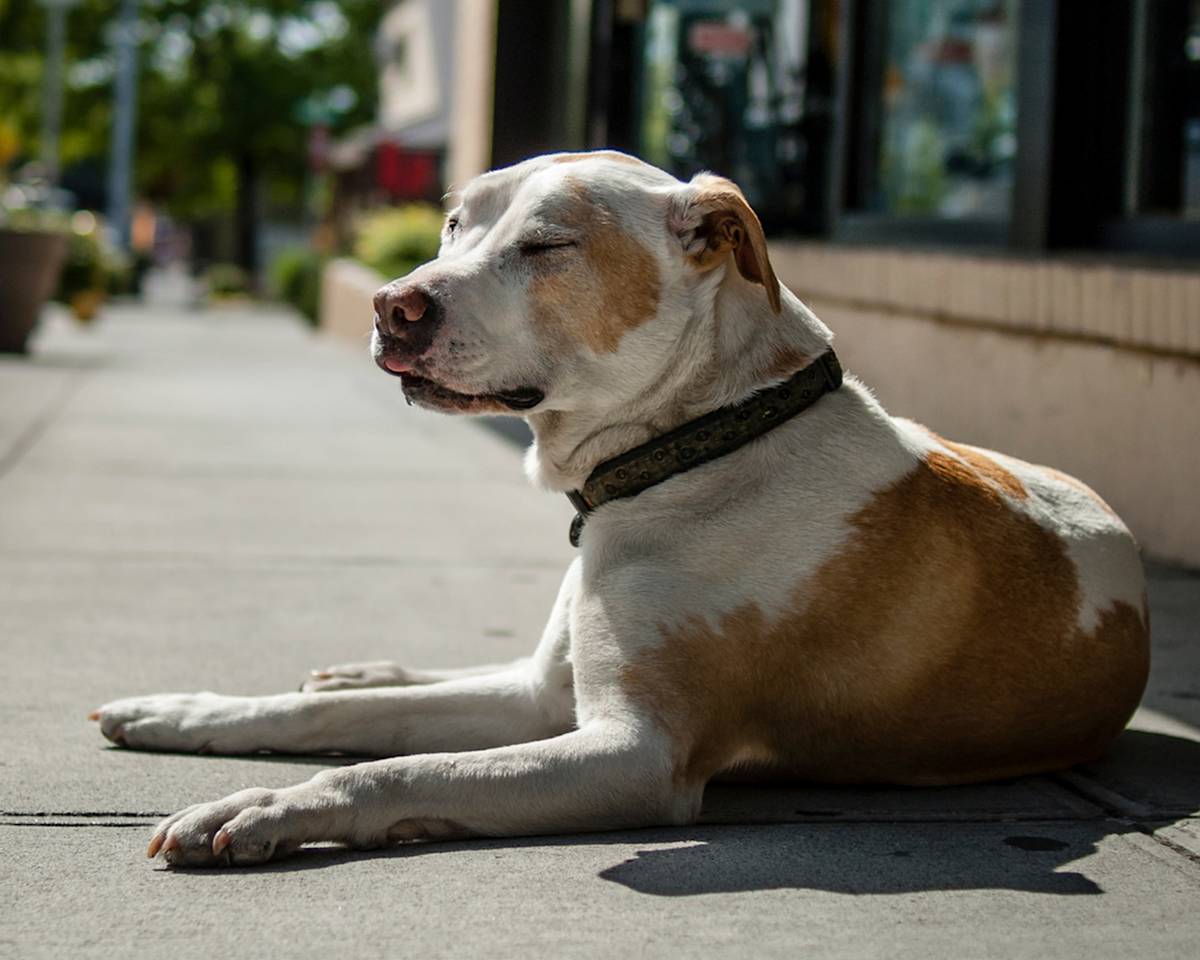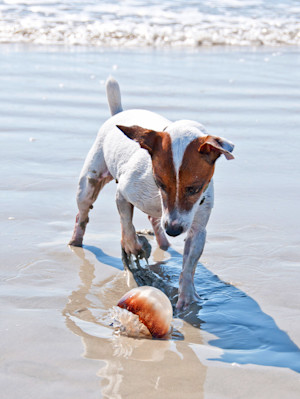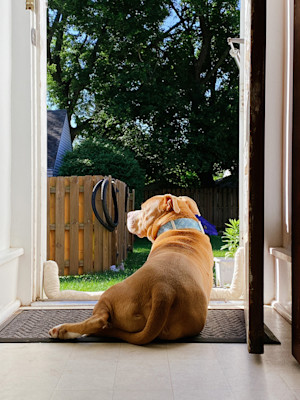When is it Too Hot to Walk Your Dog?
Even if it’s nice for us, it can very easily be too hot for your pup
In this article:
When is it too hot to walk your dog? Dog walking temperature guidelines Should you walk your dog in hot weather? Risks of walking dogs in hot weather Warm weather considerations What to do if your dog overheats Do dogs know when they overheat? Warm weather best practice Alternatives to walks in hot weather FAQs
We all love a bit of sun. And we all love our dogs. But, unfortunately, the two don’t mix very well. In fact, there’s a real risk of your dog becoming ill if you walk them when it’s too hot.
From what temperature is actually too hot for your dog, to recognising when they’re starting to overheat, here’s the lowdown on walking your dog on warmer days.
How do you know when it’s too hot to walk your dog?
There’s no hard and fast rule as every dog is an individual. And factors such as their age, breed, fitness level and health will affect how they cope with the heat and their risk level of heat-related illness. It’s also not just about the temperature – high humidity levelsopens in new tab on warm days are difficult for our dogs just as they are for us.
There are some sensible things you can do to help decide whether it’s a good idea to take your dog on a walk. Firstly, if you’re feeling hot and bothered, your dog definitely will be too.
Secondly, you can check surfaces. If the pavement’s too hot for your hand after touching it for a few seconds, it’s going to be too hot for your dog’s paws. And thirdly, if in doubt, it’s best to keep them inside. As the PDSAopens in new tab recommends, “If in doubt, don’t go out.” After all, no dog has ever died from missing one walk.
General temperature guidelines for your dog
Generally, below 20C (68F) is a safe temperatureopens in new tab for most dogs to walk in. But some dogs – particularly those who may be a bigger breed, overweight or flat-faced – can find even the high teens a struggle.
Between 20–23C (68–74F), dogs are at risk of developing heat-stroke if they are exercised for too long or too intensely. They also face a similar risk even if they aren’t exercised rigorously, but have underlying health conditions.
You should be very careful when it comes to exercising your dog in temperatures between 24–27C (75–81F). The majority of dogs will not tolerate these temperatures well and the risk of them becoming ill due to the heat is quite high.
The most dangerous temperature is 28C (82F) and above. Walking your dog in this can be a serious threat to their life.
Signs it’s too hot to walk your dog
Look at how your dog is behaving. Are they panting or seeming unsettled at home when the weather’s warm? Or seeming extra exhausted after a play session? That may be a sign they’re already struggling with the heat, so putting more stress on the body via exercise isn’t a good idea.
You can check outdoor surfaces, too. Things such as pavementsopens in new tab can absorb and store heat, making them up to 50C (122F) higher than the air temperature. So, if you can’t lay your hands or feet on a surface for at least five seconds without feeling too hot, your dog’s paws won’t be able to cope either.
Should you walk your dog in hot weather?
While physical exercise is important for dogsopens in new tab, taking them for a walk in hot weather can cause more harm than good. In some cases, it can lead to life-threatening medical issues.
There are several reasons dogs struggle in the heat. These include:
Not being able to sweat in the way that we do: dogs primarily sweatopens in new tab through their paws and mainly rely on panting to cool down. Unfortunately, these techniques aren’t very efficient or effective in warm weather. They’re even less successfulopens in new tab for dogs who struggle to breathe such as flat-faced breeds.
Having furry coats: while some dogs have thicker coats than others, having fur in general means their body will keep hold of more heat and take longeropens in new tab to cool down.
Risks of walking dogs in hot weather
Heat exhaustion
If dogs’ natural cooling mechanisms aren’t working or they’re unable to physically escape the heat, their internal body temperature will continue to riseopens in new tab and heat-related illness will begin to occur. First, they will developopens in new tab heat stress then heat exhaustion.
At this point, they may become weak and slow to react. Panting may become even more excessive and there may be other physical changes such as a dry mouth and nose, vomiting or diarrhoea.
Heat-stroke
Heat-stroke is the final and most severe stage of heat-related illness in dogs. It can result in lasting damageopens in new tab to organs and can be fatal.
One studyopens in new tab published in 2024 found that just over a quarter of dogs taken to emergency vets for heat-related illness died. Another studyopens in new tab showed that exercise was the reason for almost 75 percent of heat-stroke cases in the UK.
Burned paws
It’s not just internal damage that can occur in the heat. As pavements and similar surfaces can become very hot, it's possible for dogs’ paws to be burnedopens in new tab when walking on them.
Check your dog’s paws for any changes in colour or blistering. You may notice that some dogs lick or chew their feet, start to limp or simply refuse to walk. Take that as a sign the heat’s too much for them.
It’s worth noting that dogs should never wear shoes or booties in hot weather. You may think you’re protecting their feet from the hot ground, but dog’s sweat through their paws, so covering them in a bootie (no matter how cute they look) can severely hinder their cooling abilities.
Special considerations for walking your dog in warm weather
Age and health considerations
Some dogs will struggle more than others in the heat. Age can play a big role. Both puppies and senior dogs are more likelyopens in new tab to get heat-stroke so be extra careful when you walk them.
Similarly, dogs with underlying health issues can be at higher riskopens in new tab of becoming unwell as their body can heat up quicker and take longer to cool. This includes dogs who:
have heart disease
have respiratory conditions
are overweight
are generally unfit
are dehydrated
Breed-specific heat sensitivities
Brachycephalic, or flat-faced, breeds such as Pugs, French Bulldogs and English Bulldogs are particularly at riskopens in new tab when temperatures soar. Simply because the shorter snouts and narrowed airways that these breeds can have means they can’t breathe, pant or cool down as effectively as others.
In fact, a Vets Now studyopens in new tab found French Bulldogs were six times more likely to get heat-stroke compared to a Labrador. And French Bulldogs and English Bulldogs made up over a third of heat-stroke cases.
The same study also looked at dogs with double coats who may struggle to quickly lose heat, finding that Chow Chows were almost 12 times more likely to develop heat-stroke than a Labrador.
However, some surprising breedsopens in new tab have also been found to have an increased risk of heat-related illness. Springer Spaniels and Border Collies being two. It’s possible that being energetic and highly motivated, these breeds may be more inclinedopens in new tab to move around lots in the heat and continue moving even if they’re feeling hot.
What to do if your dog overheats
It’s important to take actionopens in new tab quickly if your dog’s gotten too hot. First, stop any exercise and move them into a cool, shady spot where they can rest. Ensure they have small amounts of cool water to drink.
Then contact your vet immediately who will be able to let you know what to do and if you need to bring your dog in to be seen.
Often, they will advise you to start cooling your dog down until their breathing settles before you transport them. This will involve pouring cool water over them, being careful that they’re not inhaling any water by avoiding their head area.
If you have a place you can immerse them in such as a paddling pool and your dog is young and healthy, you can do this but ensure their head is kept above water.
Older dogs or dogs with health issues do betteropens in new tab with being sprayed with cool water, avoiding their face, and using a fan or air conditioning if you can.
Don’t place wet towels over them as this can trap the heat, and make their body temperature rise even more, making things worse. And be sure to monitor them and stop what you’re doing if they start shivering.
How to recognise heat-stroke in dogs
Spotting early signs that your dog’s distressed from the heat is vital for keeping them safeopens in new tab. Here are some specific things to look out for:
Excessive panting or drooling, even when they’re resting.
Unusual noises or difficulty when breathing.
Gums or tongue that have turned blue or grey in colour.
Glassy eyes.
Seeming excessively tired.
Seeming clumsy or unsteady.
Vomiting or diarrhoea.
Collapsing.
Not responding to you.
Won’t my dog know when they’ve had enough heat?
Unfortunately not. Dogs will often continue running around and playing even when they’re exhausted or feeling hot, particularly if they find it fun. So it’s up to us to be responsible when exercising them and watch out for early signs that they’re struggling.
Best practices for walking your dog during hot weather
If you are going to walk your dog on warmer days, then ensure they’re walked at cooler times such as early in the morning. Even evenings can be too warm on some days so keep an eye on the temperature and humidity level.
Try to stick to shadier spots such as woodlands, avoiding pavement or asphalt surfaces that can become excessively hot.
And make sure you have water and a portable bowl on you at all times, having regular breaks throughout your walk.
As for the type of exercise you do, keep it calm. Avoid high intensity activities like repetitive ball throwing, running or cycling with your dog and keep the walk shorter than normal if you need to. Stop before they start to really struggle.
Alternatives to walks in hot weather
Don’t forget that it’s okay for your dog to miss a walk and that there are plenty of ways to stimulate them at home instead.
Why not set up a small pool if you have the space so they can have some water fun? Or give them some frozen treats in Kongs or lickimats to occupy them. Even puzzle games and short training sessions can come in handy on hot days.
Finally, it’s perfectly OK to just have a rest day and chill out with them. It’s good for them as much as it is for us!
Bottom line: how hot is too hot to walk your dog?
While temperatures below 20C (68F) may be okay for most, every dog is different. So watch how your dog copes in various temperatures and adjust their walks to suit. If you’re not sure, then it’s always best to be safe and stay home. Remember: if in doubt, sit it out!
Frequently asked questions: when is it too hot to walk your dog?
What is the best time to walk my dog in the summer?
Early mornings are often best. On really hot days, that may be before 8am. Some late evenings may also work, but humidity can remain in the evenings so keep an eye on things.
Can I walk my dog in 25C weather?
This temperature would be very uncomfortable for a lot of dogs and potentially dangerous. Vets Nowopens in new tab gives an eight out of ten risk rating for temperatures between 24–27C (75–81F) and advises being extremely cautious. So only walk your dog if you absolutely need to – for example, a quick toilet walk.
What surfaces are safest in hot weather?
Tarmac or concrete surfaces – so your typical pavements – can become very, very hot so it’s best to avoid those. Instead, opt for grassy or shaded surfaces. And remember that if it’s too hot for your hands or feet, it’s too hot for your dog!
What should I bring for hot weather walks?
Lots of water is a must along with something for your dog to drink from. If your dog needs some extra help to remain cool and must be outside, consider accessories such as cooling vests.
Don’t forget to bring your phone too just in case of an emergencyopens in new tab.
Is 28C too hot for a dog walk?
Yes, walking your dog at 28C (82F) should be avoided. It’s dangerousopens in new tab for all dogs to be exercising in that kind of temperature and may even be life-threatening for some, including puppies, senior dogs and flat-faced breeds.
This information is not meant to be a substitute for veterinary care. Always follow the instructions provided by your vet.
Resources
Aletba, Salam Ridha Oleiwi, et al. “Thermal Performance of Cooling Strategies for Asphalt Pavement: A State-of-The-Art Review.”opens in new tab Journal of Traffic and Transportation Engineering (English Edition), vol. 8, no. 3, June 2021, pp. 356–73.
Beard, Sian, et al. “Epidemiology of Heat‐Related Illness in Dogs under UK Emergency Veterinary Care in 2022.opens in new tab” Veterinary Record, vol. 194, no. 11, Wiley, May 2024.
“Dogs Die on Hot Walks: Know How to Keep Your Dog Safe in Extreme Heat.opens in new tab” British Veterinary Association, 2022.
“Five Top Tips for Keeping Furry Friends Safe in Hot Weather.opens in new tab” PDSA, pdsa.org.uk, 2022.
“Flat-Faced Dogs such as Bulldogs, French Bulldogs and Pugs at Increased Risk of Heat Stroke.opens in new tab” Royal Veterinary Association, rvc.ac.uk.
Hall, Emily J., et al. “Dogs Don’t Die Just in Hot Cars—Exertional Heat-Related Illness (Heatstroke) Is a Greater Threat to UK Dogs.opens in new tab” Animals, vol. 10, no. 8, July 2020, p. 1324.
“HotDogs Heatstroke Study.opens in new tab” Summer Hub, 14 Feb. 2025.
“Why Is Humidity Important?opens in new tab” Met Office, 21 June 2018.
“The Three Progressive Stages of Heat-Related Illness in Dogs.opens in new tab” Eukanuba, 2024.
“Treatment for Heatstroke | Dog First Aid | RSPCA.opens in new tab” Rspca.org.uk, 2017.
“Caring for Your Dog during Hot Weather.opens in new tab” Dogstrust.org.uk, 13 July 2022.









